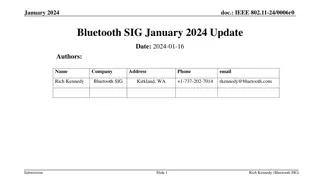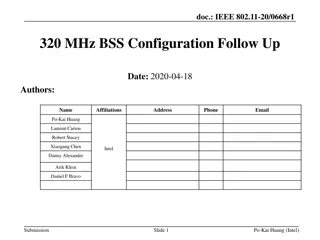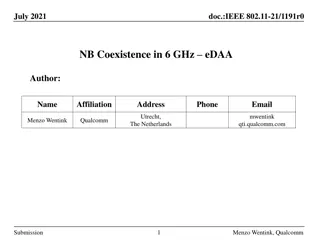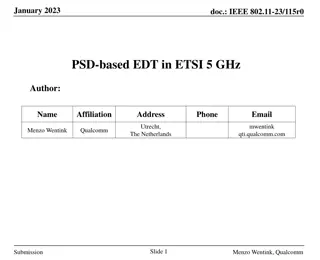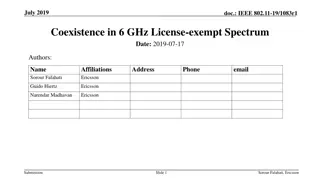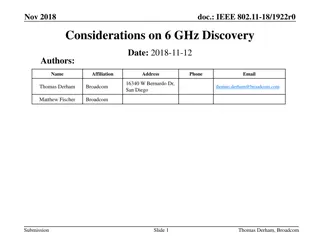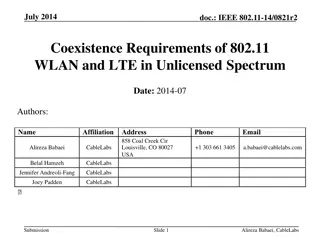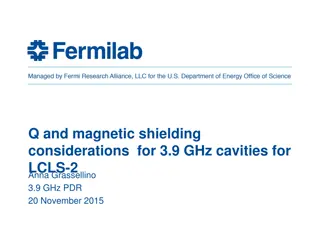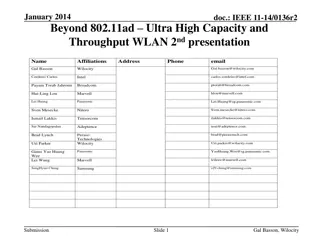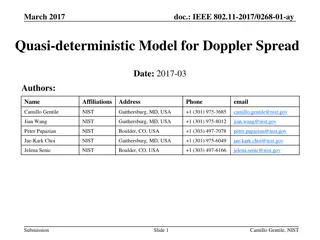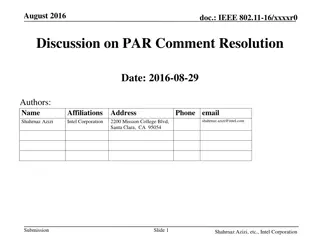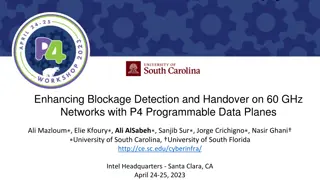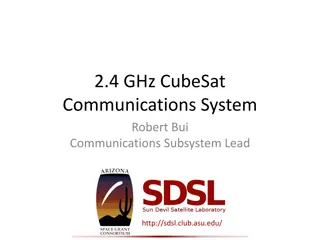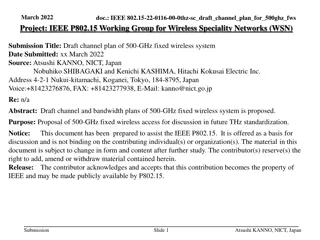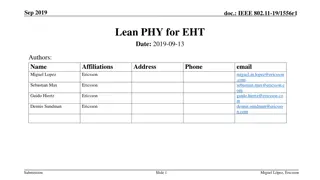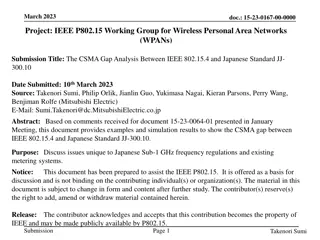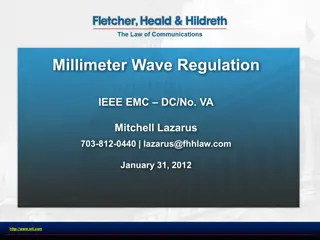Computational Physics (Lecture 18)
Neural networks explained with the example of feedforward vs. recurrent networks. Feedforward networks propagate data, while recurrent models allow loops for cascade effects. Recurrent networks are less influential but closer to the brain's function. Introduction to handwritten digit classification
0 views • 55 slides
Evolution and Potential of 5G Technology
Explore the evolving landscape of 5G technology, from enhanced mobile broadband to groundbreaking use cases and standalone networks. Learn how supportive regulations and spectrum allocation are vital for unlocking 5G's full potential. Discover the transformative impact of Standalone 5G networks on i
8 views • 10 slides
High-Level Thoughts on Integrated mmWave Communication for WLAN Solutions
Market demands for WLAN solutions supporting high throughput and low latency applications have led to the development of Integrated mmWave (IMMW). This project focuses on integrating the mmwave band with sub-7GHz links to overcome range, mobility, and reliability challenges. IMMW aims to harmonize d
1 views • 7 slides
Understanding Computer Networks: Types and Characteristics
In the realm of computer networks, nodes share resources through digital telecommunications networks. These networks enable lightning-fast data exchange and boast attributes like speed, accuracy, diligence, versatility, and vast storage capabilities. Additionally, various types of networks exist tod
9 views • 12 slides
Bluetooth SIG September 2023 Update on Spectrum Sharing Plans
Bluetooth SIG provided an update on their actions and plans for sharing the 5 and 6 GHz bands with incumbents and unlicensed devices. They aim to collaborate with the Wi-Fi industry to enable equitable sharing for Bluetooth, particularly focusing on the 6 GHz band. The overall plan includes forming
4 views • 8 slides
Graph Neural Networks
Graph Neural Networks (GNNs) are a versatile form of neural networks that encompass various network architectures like NNs, CNNs, and RNNs, as well as unsupervised learning models such as RBM and DBNs. They find applications in diverse fields such as object detection, machine translation, and drug d
2 views • 48 slides
Revising ETSI Standard for License-Exempt Operation in 6 GHz Band
Work has commenced on revising the ETSI standard EN 303.687 for license-exempt operation in the 6 GHz band to expedite completion. This revision project outlines the history, New Work Item approval, ETSI processes, and the upcoming steps. It traces back to 2017 when Switzerland and ECC administratio
0 views • 10 slides
Update on Bluetooth SIG's Spectrum Sharing Plans
This update discusses Bluetooth SIG's actions and plans for sharing the 5 and 6 GHz bands with incumbents and unlicensed devices. It highlights the goals, the overall plan, recent actions, and collaboration with the Wi-Fi industry to enable equitable sharing of these bands. The detailed plan involve
0 views • 9 slides
Update on Bluetooth SIG's Plans for Spectrum Sharing in January 2024
Bluetooth SIG presents an update on their actions and plans for sharing the 5 and 6 GHz bands with incumbents and unlicensed devices. Recognizing the need for future growth, they aim to collaborate with the Wi-Fi industry to develop optimal sharing mechanisms in the 6 GHz band. Their plan includes c
0 views • 11 slides
IEEE 802.11-20/0668r1: EHT BSS Configuration Proposal
The document discusses the configuration of a 320 MHz BSS in the context of 6 GHz regulations, focusing on EHT operation elements such as channel width indication, CCFS principles, and BSS advertisement settings. It proposes design principles for managing legacy and EHT STA operations, emphasizing s
0 views • 14 slides
Understanding Artificial Neural Networks From Scratch
Learn how to build artificial neural networks from scratch, focusing on multi-level feedforward networks like multi-level perceptrons. Discover how neural networks function, including training large networks in parallel and distributed systems, and grasp concepts such as learning non-linear function
1 views • 33 slides
Coexistence Challenges and Solutions in 6 GHz Networks
Various submissions address narrowband (NB) coexistence issues in the 6 GHz frequency band, focusing on Enhanced Detect and Avoid (eDAA) mechanisms to ensure harmonious coexistence between Wi-Fi and NB devices. The proposals discuss channel access rules, interference measurements, simulation results
1 views • 14 slides
Understanding Back-Propagation Algorithm in Neural Networks
Artificial Neural Networks aim to mimic brain processing. Back-propagation is a key method to train these networks, optimizing weights to minimize loss. Multi-layer networks enable learning complex patterns by creating internal representations. Historical background traces the development from early
1 views • 24 slides
Understanding Interconnection Networks in Multiprocessor Systems
Interconnection networks are essential in multiprocessor systems, linking processing elements, memory modules, and I/O units. They enable data exchange between processors and memory units, determining system performance. Fully connected interconnection networks offer high reliability but require ext
1 views • 19 slides
PSD-based Energy Detect Threshold (EDT) in ETSI 5 GHz Standard
ETSI BRAN adopted a PSD-based EDT into the 5 GHz standard, specifying thresholds for energy detection levels. The new definition replaces the previous -72 dBm/20 MHz EDT, offering a compromise between power limits and channel configurations. Detailed examples and operational guidelines are provided
0 views • 6 slides
Coexistence in 6 GHz License-Exempt Spectrum - IEEE 802.11-19/1083r1
This document discusses the principles and key features of unlicensed spectrum in the 6 GHz frequency band, focusing on coexistence with incumbent services, spectrum efficiency, and regulatory discussions. It also delves into channel access design for 3GPP technologies in the 5 GHz band, highlightin
0 views • 12 slides
Considerations on PHY for 60 GHz in IEEE 802.11-22/1865r0 Document
The document discusses the possibility of standardizing multi-link (ML) with bands in the sub-7 GHz range combined with bands in the 45-72 GHz range, proposing reusing a sub-7 GHz PHY for mmWave bands. It explores the impact of phase noise on choosing the OFDM numerology for operation in the 45-72 G
1 views • 13 slides
Considerations on 6 GHz Discovery for IEEE 802.11-18/1922r0
IEEE 802.11-18/1922r0 document discusses the background and regulatory context for supporting 6 GHz operation in 802.11ax networks. It focuses on optimizing the discovery process for 6 GHz channels to enhance STA and network KPIs. The typical scanning/discovery procedure for non-AP STAs is outlined,
2 views • 14 slides
Introduction to Neural Networks in IBM SPSS Modeler 14.2
This presentation provides an introduction to neural networks in IBM SPSS Modeler 14.2. It covers the concepts of directed data mining using neural networks, the structure of neural networks, terms associated with neural networks, and the process of inputs and outputs in neural network models. The d
0 views • 18 slides
Key Coexistence Issues in 5-7 GHz Unlicensed Spectrum for NR Sidelink Evolution
3GPP RAN1 is extending NR sidelink operation to 5-7 GHz unlicensed spectrum, raising concerns about channel access and physical design. Discussions include Listen Before Talk protocols, UE-to-UE COT sharing, and coexistence with WiFi technologies. The study aims to specify support for sidelink on un
0 views • 14 slides
Coexistence Requirements of 802.11 WLAN and LTE in Unlicensed Spectrum
Presentation from July 2014 discussing the impact of LTE in unlicensed spectrum on 802.11 WLAN networks. Highlights proposals for TGax functional requirements document. Examines LTE-U and its challenges for coexistence with other technologies like Wi-Fi. Details LTE quiet periods and lab test condit
0 views • 12 slides
P-Rank: A Comprehensive Structural Similarity Measure over Information Networks
Analyzing the concept of structural similarity within Information Networks (INs), the study introduces P-Rank as a more advanced alternative to SimRank. By addressing the limitations of SimRank and offering a more efficient computational approach, P-Rank aims to provide a comprehensive measure of si
0 views • 17 slides
Understanding Magnetic Shielding Considerations for 3.9 GHz Cavities
This document discusses Q and magnetic shielding considerations for 3.9 GHz cavities used in the LCLS-II project, highlighting the unique behavior observed in nitrogen-treated cavities. The study delves into the improved Q values and field dependence of quality factors, challenging traditional niobi
0 views • 10 slides
802.11aj 45 GHz Channel Access and BSS Operation Framework Proposal
This document outlines a proposal for channel operation and BSS operation in the 45 GHz frequency bands for 802.11aj in China. It includes details on channelization, spectrum allocation, maximum transmit power, and BSS configuration rules. The aim is to meet the functional requirements specified whi
0 views • 32 slides
Beyond 802.11ad: Ultra High Capacity and Throughput WLAN
The document from January 2014 discusses the exploration of modifications to IEEE 802.11ad-2012 PHY and MAC layers to enable modes of operation in the 60 GHz band capable of achieving a maximum throughput of at least 30 Gbps while maintaining the band's excellent capacity attributes. Topics include
0 views • 21 slides
Parameterized Model for Doppler Spread in mmWave Systems
This document presents a parameterized model for Doppler spread in mmWave systems based on measurements with an 83 GHz channel sounder. The model is linked to the Quasi-deterministic (QD) propagation channel model adopted by the work group. It discusses Doppler frequency shift, channel sounder confi
0 views • 10 slides
Understanding Overlay Networks and Distributed Hash Tables
Overlay networks are logical networks built on top of lower-layer networks, allowing for efficient data lookup and reliable communication. They come in unstructured and structured forms, with examples like Gnutella and BitTorrent. Distributed Hash Tables (DHTs) are used in real-world applications li
0 views • 45 slides
Understanding Networks: An Introduction to the World of Connections
Networks define the structure of interactions between agents, portraying relationships as ties or links. Various examples such as the 9/11 terrorists network, international trade network, biological networks, and historical marriage alliances in Florence illustrate the power dynamics within differen
0 views • 46 slides
IEEE 802.11-16/xxxxr0 August 2016 Discussion Summary
The document discusses comments and proposed resolutions regarding user data, different bands, operation, and latency in IEEE 802.11-16/xxxxr0. Various categories like wake-up packets, band definitions for 2.4 GHz and 5 GHz, radio transitions, and ongoing latency discussions are tackled in this Augu
0 views • 8 slides
Enhancing Blockage Detection and Handover on 60 GHz Networks with P4 Programmable Data Planes
The study presents a system using programmable switches to monitor packet inter-arrival time for blockage detection on mmWave networks. Results show fast recovery speeds and minimal impact on flow completion time, with contributions focusing on leveraging programmable switches and real device scenar
0 views • 7 slides
Understanding Network Analysis: Whole Networks vs. Ego Networks
Explore the differences between Whole Networks and Ego Networks in social network analysis. Whole Networks provide comprehensive information about all nodes and links, enabling the computation of network-level statistics. On the other hand, Ego Networks focus on a sample of nodes, limiting the abili
0 views • 31 slides
2.4 GHz CubeSat Communications System Overview
The 2.4 GHz CubeSat Communications System, led by Robert Bui, aims to establish a reliable data link between the SDS-1 Cube Satellite and the ASU ground station. Operating on the 13 cm amateur ham radio band at frequencies of 2400-2450 MHz, the system utilizes a Transceiver (MHX-2420) with a link ra
0 views • 10 slides
Evolution of Networking: Embracing Software-Defined Networks
Embrace the future of networking by transitioning to Software-Defined Networks (SDN), overcoming drawbacks of current paradigms. Explore SDN's motivation, OpenFlow API, challenges, and use-cases. Compare the complexities of today's distributed, error-prone networks with the simplicity and efficiency
0 views • 36 slides
Draft Channel Plan of 500-GHz Fixed Wireless System for Ultra-High-Definition Surveillance
Proposed is a draft channel plan for a 500-GHz fixed wireless system suitable for ultra-high-definition surveillance applications in smart industries and public transportation. This system aims to enable high-capacity data transmission with low spectrum interference in short-distance links, offering
0 views • 10 slides
Relevance of Lean PHY for EHT in 6 GHz
Discussing the importance of a Lean PHY for EHT in 6 GHz to improve spectrum efficiency and reduce overhead. Introducing the Low Throughput PHY as a potential solution, highlighting its benefits compared to existing options like 802.11a. Measurement results show the impact and potential for enhancin
0 views • 14 slides
Next-Generation 60 GHz Peak Data Rate Technologies
This presentation delves into the exploration of potential technologies to meet the peak data rate requirements of NG-60, focusing on enhancements to IEEE 802.11 physical and medium access control layers. Various channel bonding scenarios and achievable peak data rates are discussed, aiming to reach
0 views • 9 slides
Understanding Interconnection Networks in Embedded Computer Architecture
Explore the intricacies of interconnection networks in embedded computer architecture, covering topics such as connecting multiple processors, topologies, routing, deadlock, switching, and performance considerations. Learn about parallel computer systems, cache interconnections, network-on-chip, sha
0 views • 43 slides
Understanding Deep Generative Bayesian Networks in Machine Learning
Exploring the differences between Neural Networks and Bayesian Neural Networks, the advantages of the latter including robustness and adaptation capabilities, the Bayesian theory behind these networks, and insights into the comparison with regular neural network theory. Dive into the complexities, u
0 views • 22 slides
CSMA Gap Analysis Between IEEE 802.15.4 and Japanese Standard JJ-300.10
This document analyzes the differences in CSMA protocol and performance between IEEE 802.15.4 and Japanese Standard JJ-300.10, focusing on unique issues related to Japanese Sub-1 GHz frequency regulations and metering systems. With increasing data traffic and channel access demands, insights are pro
0 views • 19 slides
Understanding Millimeter Wave Regulation and FCC Restricted Bands
Overview of millimeter wave regulation by IEEE and FCC, including restricted bands, radar rules, advantages and disadvantages of millimeter wave signals, and FCC rules on restricted bands above 38.6 GHz. Details on communication bands, power regulations, and proposals for unlicensed usage in the 57-
0 views • 19 slides








